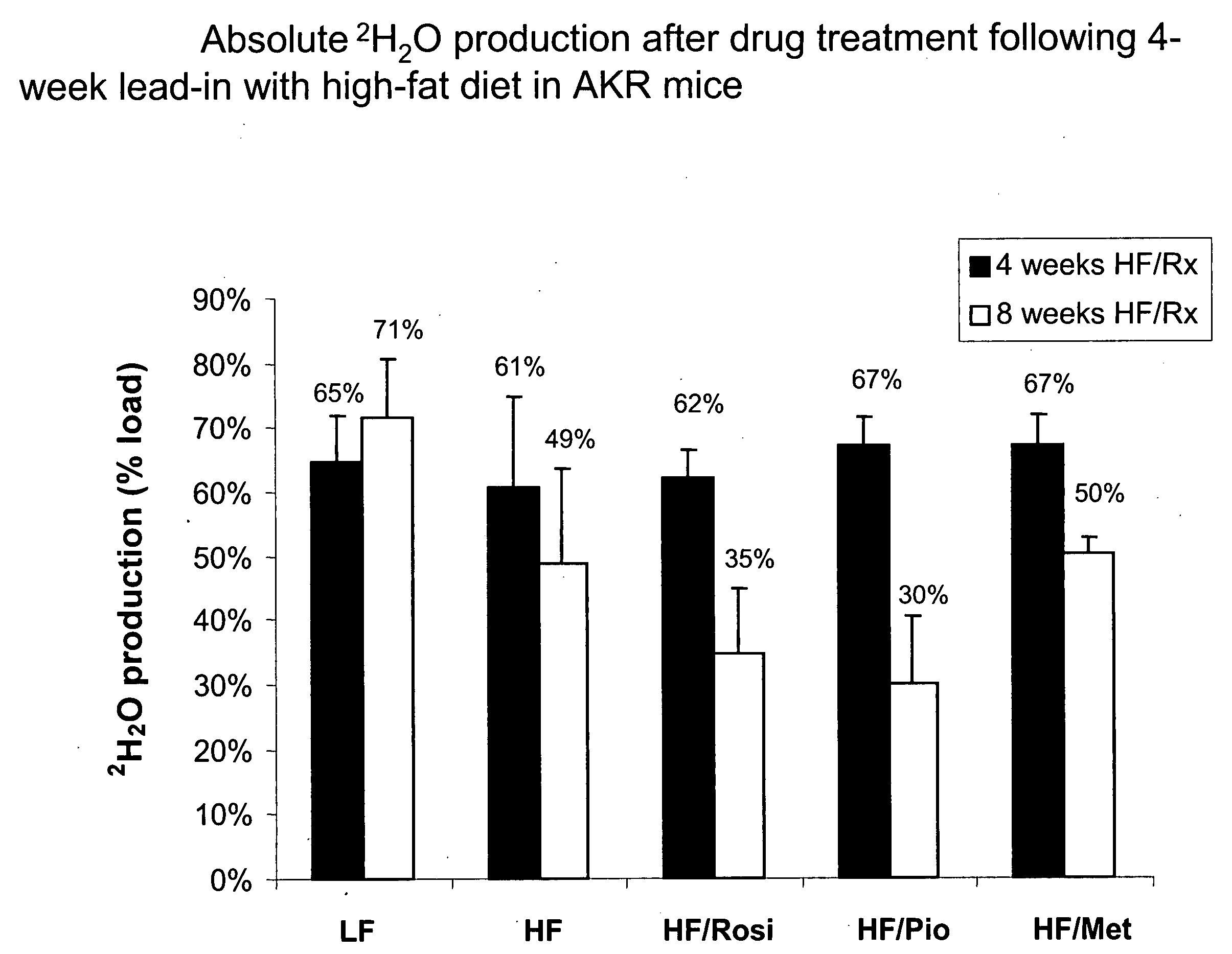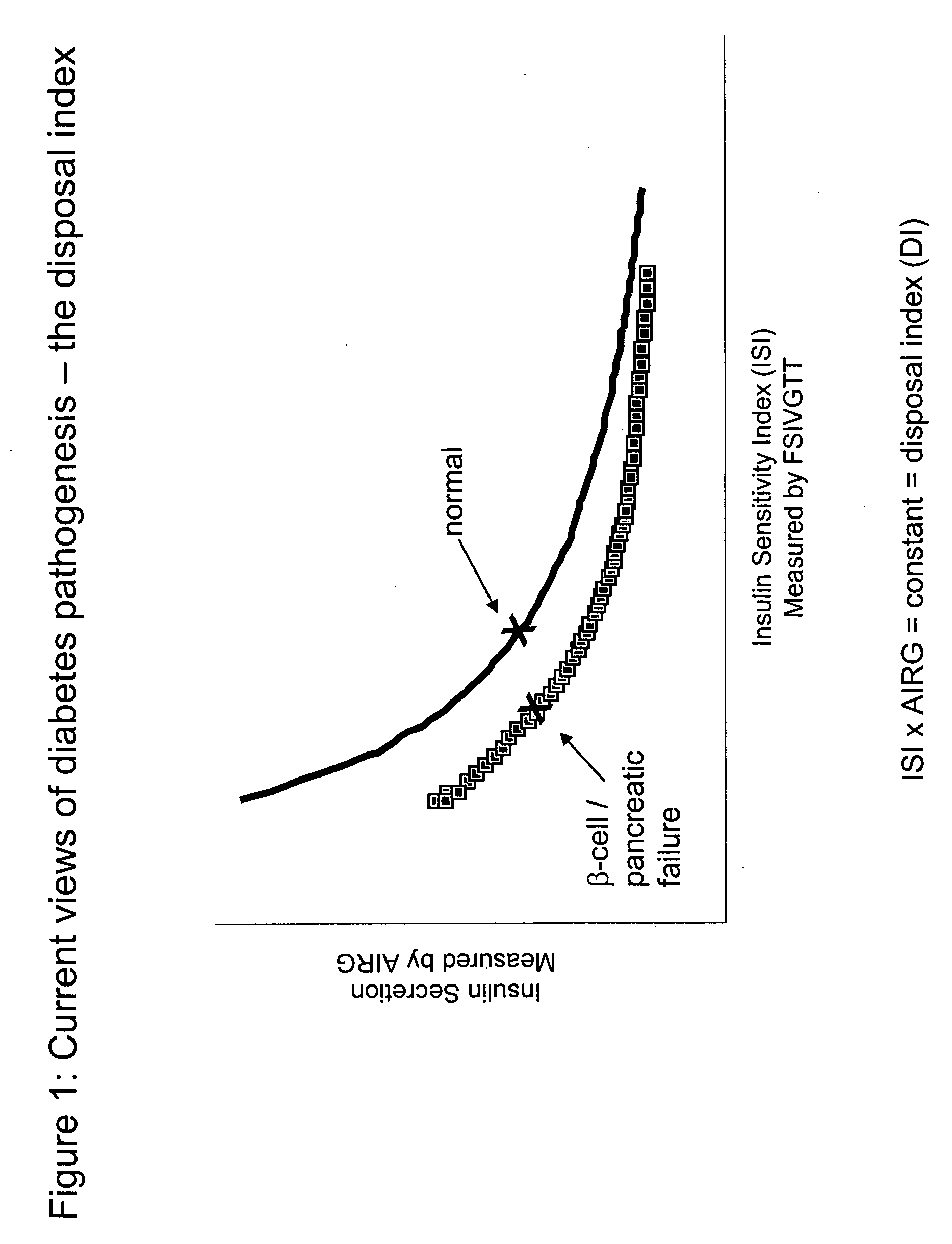Monitoring two dimensions of diabetes pathogenesis seperately or concurrently (insulin sensitivity and beta-cell sufficiency): uses in diagnosis, prognosis, assessment of disease risk, and drug development
a technology of insulin sensitivity and beta-cell sufficiency, applied in the field of diabetes mellitus, can solve the problems of inability to maintain constant, difficult to use clinical diagnostics, and inability to detect fs ivgtt, etc., and achieve the effect of convenient and widespread use of tests
- Summary
- Abstract
- Description
- Claims
- Application Information
AI Technical Summary
Benefits of technology
Problems solved by technology
Method used
Image
Examples
example 1
Monitoring of a Human Subject
[0190] A human subject may be tested by the methods disclosed herein. A subject, who had fasted overnight, enters the clinic and has blood drawn (0 hour timepoint), and then receives a solution containing 75 grams of glucose. 15 of the 75 grams of glucose would be 6,62H2-glucose. The subject drinks the glucose solution. The subject then has additional blood drawn at 1, 2, 3, and 4 hours after drinking the solution (1, 2, 3, and 4 hour timepoints).
[0191] Portions of the blood from all five timepoints are sent out for insulin measurement, as described, supra. The insulin AUC is determined as described, supra.
[0192] A portion of the blood from the four hour timepoint is processed for 2H2O analysis. Specifically, 100 ul of the blood is transferred to the inverted cap of a 2 ml polypropylene screw cap vial, the vial is screwed onto the cap, and the inverted vial is placed in a 70 degree Celsius glass bead filled heating block overnight. The condensed vapor...
example 2
Longitudinal Monitoring of Obese, Non-DM Individuals:
[0194] An obese non-DM subject was tested by the methods disclosed herein. Absolute heavy water production was 45 mMoles (out of 83 mMoles administered in deuterated glucose). Normal values are >40-50 mMoles (FIG. 7). The Insulin AUC (INS AUC) was 1.8 nM-hours / liter. The 2H2O / INS AUC was 45 / 1.8=25. Normal values are 50 and above (FIG. 7). The subject plotted on the two-dimensional graph falls into the compensated insulin resistance (upper left) quadrant (FIG. 7). The subject will be tested again one year later. The following scenarios may be observed: [0195] a) 2H2O / INS AUC decreases to 12, while absolute heavy water production remains stable at 45 nMoles (arrow # 1, FIG. 7). The interpretation would be that this person has worse insulin resistance but that the pancreas is keeping up and that beta-cell compensation is adequate. [0196] b) 2H2O / INS AUC decreases to 22 while absolute heavy water production falls to 30 mMoles (arrow ...
example 3
Differentiation Between Types 1 and 2 DM
[0198] A normal weight 29-year-old subject is diagnosed with diabetes. The question of DM1 vs. DM2 is uncertain. The test disclosed herein is performed. The results show that 2H2O / INS AUC is in the normal range (75), while absolute heavy water production is low (25 mMoles) putting the subject in the lower right quadrant of FIG. 7. The conclusion is that this subject does not have insulin resistance but has primary pancreatic insufficiency, consistent with DM1.
PUM
 Login to View More
Login to View More Abstract
Description
Claims
Application Information
 Login to View More
Login to View More - R&D
- Intellectual Property
- Life Sciences
- Materials
- Tech Scout
- Unparalleled Data Quality
- Higher Quality Content
- 60% Fewer Hallucinations
Browse by: Latest US Patents, China's latest patents, Technical Efficacy Thesaurus, Application Domain, Technology Topic, Popular Technical Reports.
© 2025 PatSnap. All rights reserved.Legal|Privacy policy|Modern Slavery Act Transparency Statement|Sitemap|About US| Contact US: help@patsnap.com



